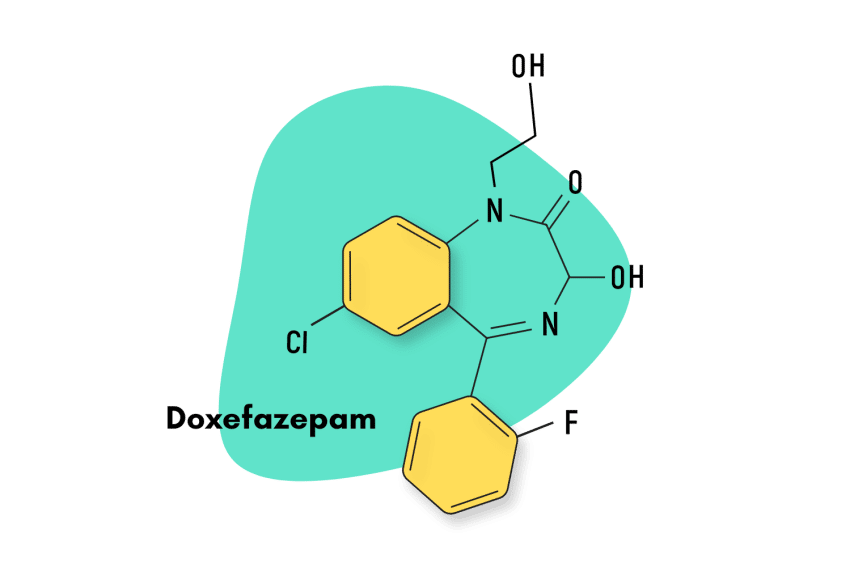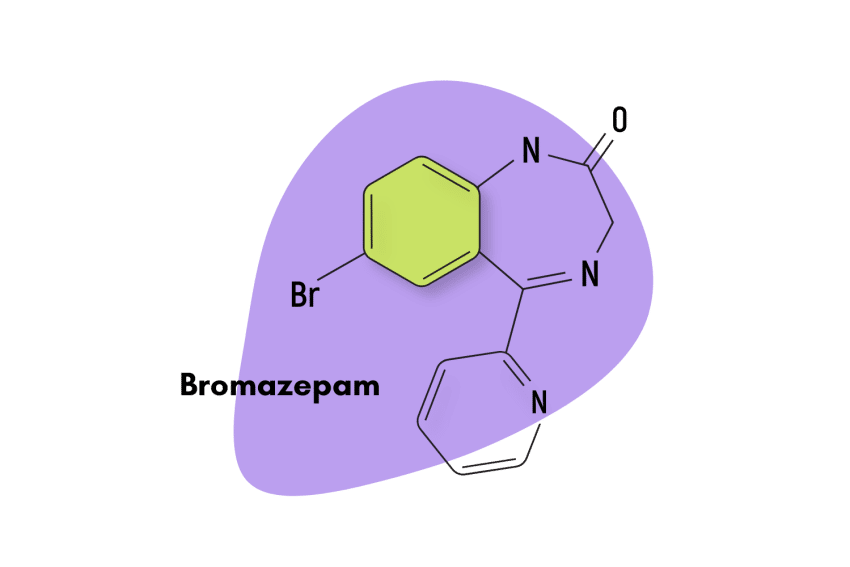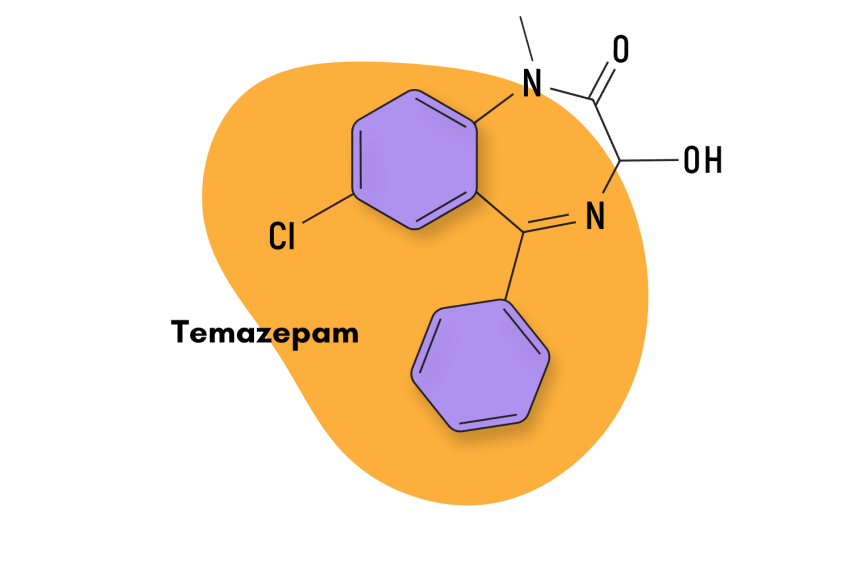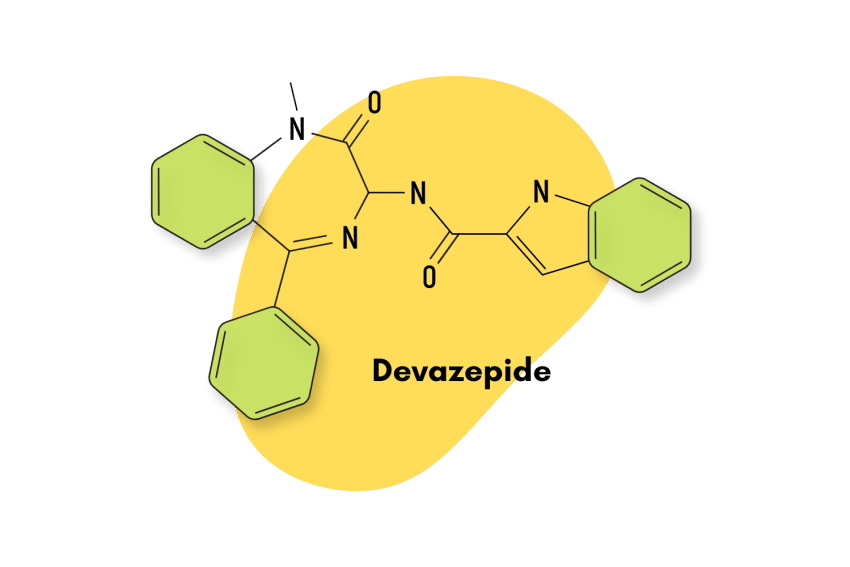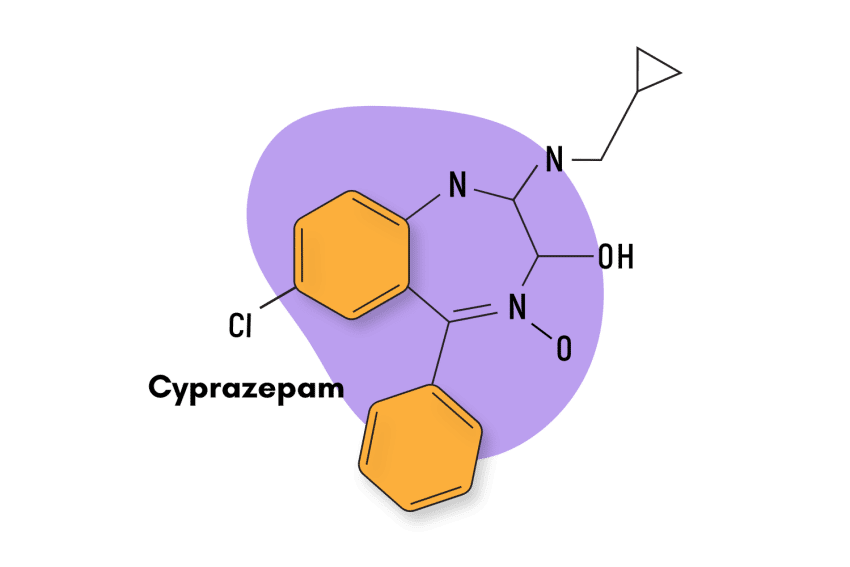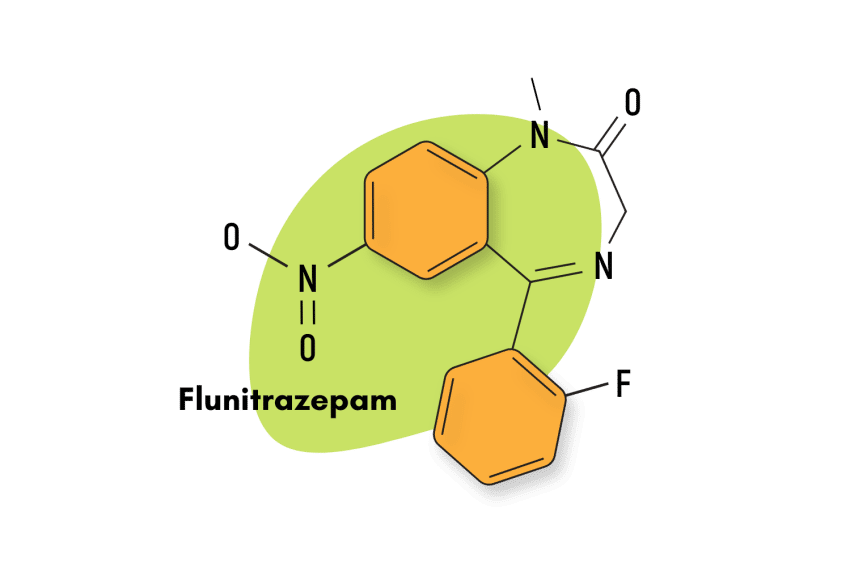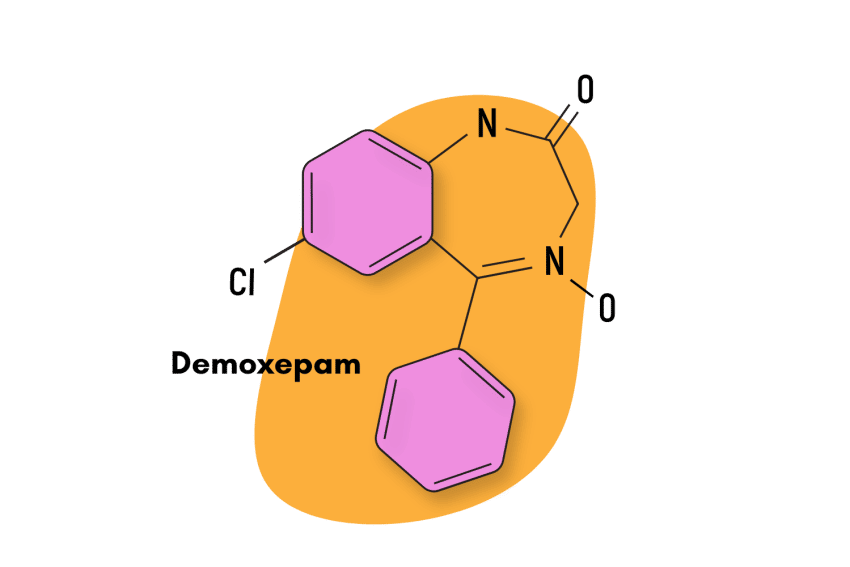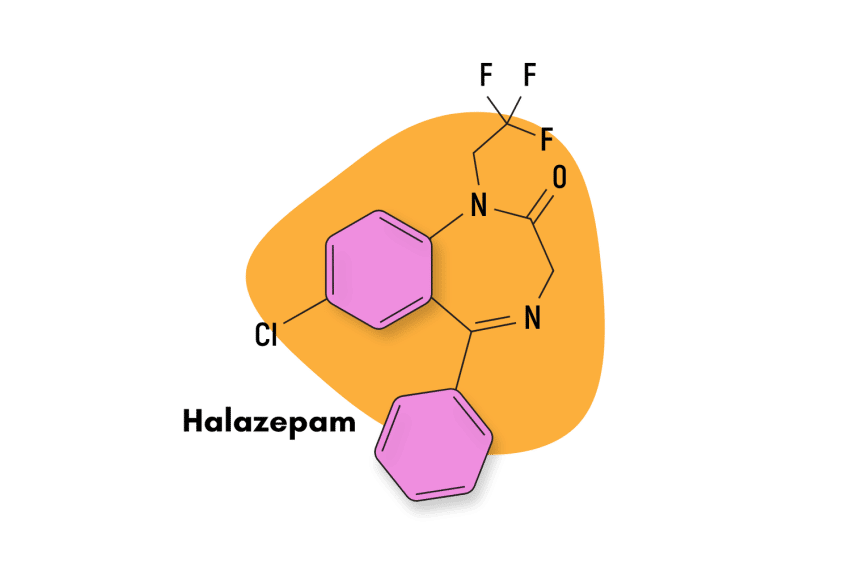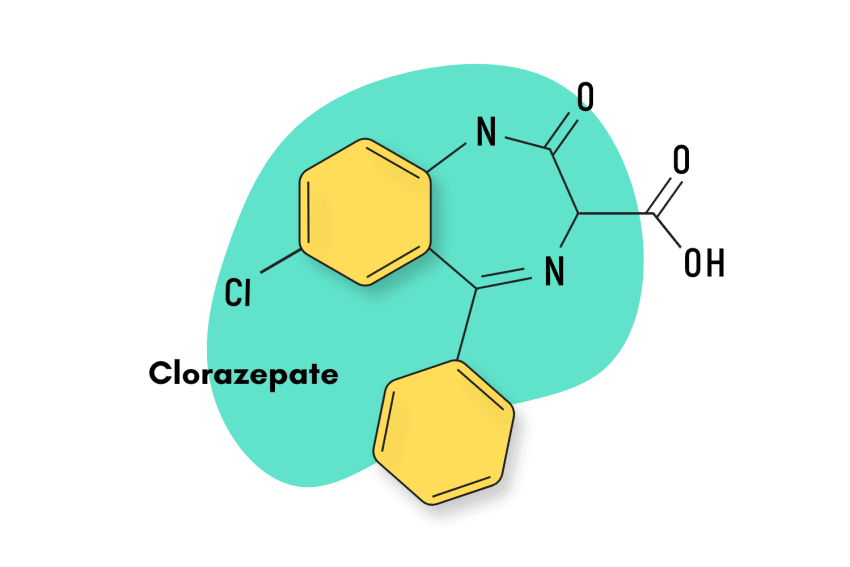Cinolazepam (Gerodorm) Fact Sheet & Harm Reduction Guide
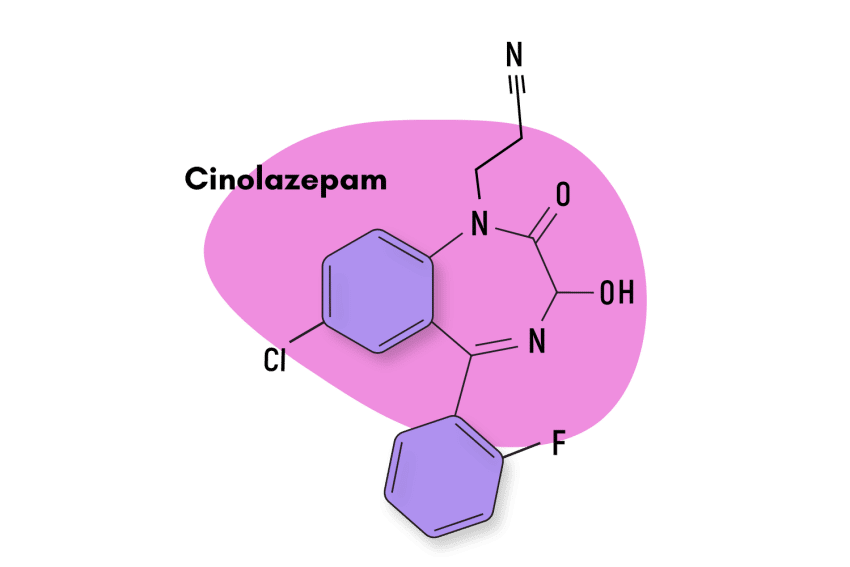
Cinolazepam — available commercially as Gerodorm — is a benzodiazepine derivative of the 1,4-benzodiazepine subtype. It’s closely related to other benzodiazepines such as Librium (chlordiazepoxide), Valium (diazepam), and Klonopin (clonazepam).
Regarding its general characteristics, cinolazepam is intermediate-acting, with an elimination half-life of 8 to 12 hours. Its potency is quite low relative to other benzodiazepines.
Cinolazepam has not been approved for sale in the United States or Canada. However, it is approved in other countries like Romania and other European countries.
In the countries where it is approved, cinolazepam is indicated for treating sleep-related disorders.
Cinolazepam (Gerodorm) Specs
| Status | Approved medication (Not available in the USA) |
| Common Dosage | 20-40 mg |
| PubChem ID | 3033621 |
| CAS# | 75696-02-5 |
IUPAC Name:
3-[7-chloro-5-(2-fluorophenyl)-3-hydroxy-2-oxo-3H-1,4-benzodiazepin-1-yl]propanenitrile
Other Names: Gerodorm
Metabolism
The only study that tangentially looks at cinolazepam’s metabolism makes it clear that despite being marketed drugs, there is no conclusive scientific literature on the exact metabolic pathways this drug follows after consumption [1].
However, we do know that cinolazepam’s metabolism is hepatic and that it produces three metabolites, one known as N-(hydroxyethyl) and two which were identified in the study as “glucuronides” [1]. We also know that these metabolites were formed by “modification at the side chain or conjugation to the hydroxy group.”
Duration of Effects
Cinolazepam is reported as having an elimination half-life averaging nine hours [2].
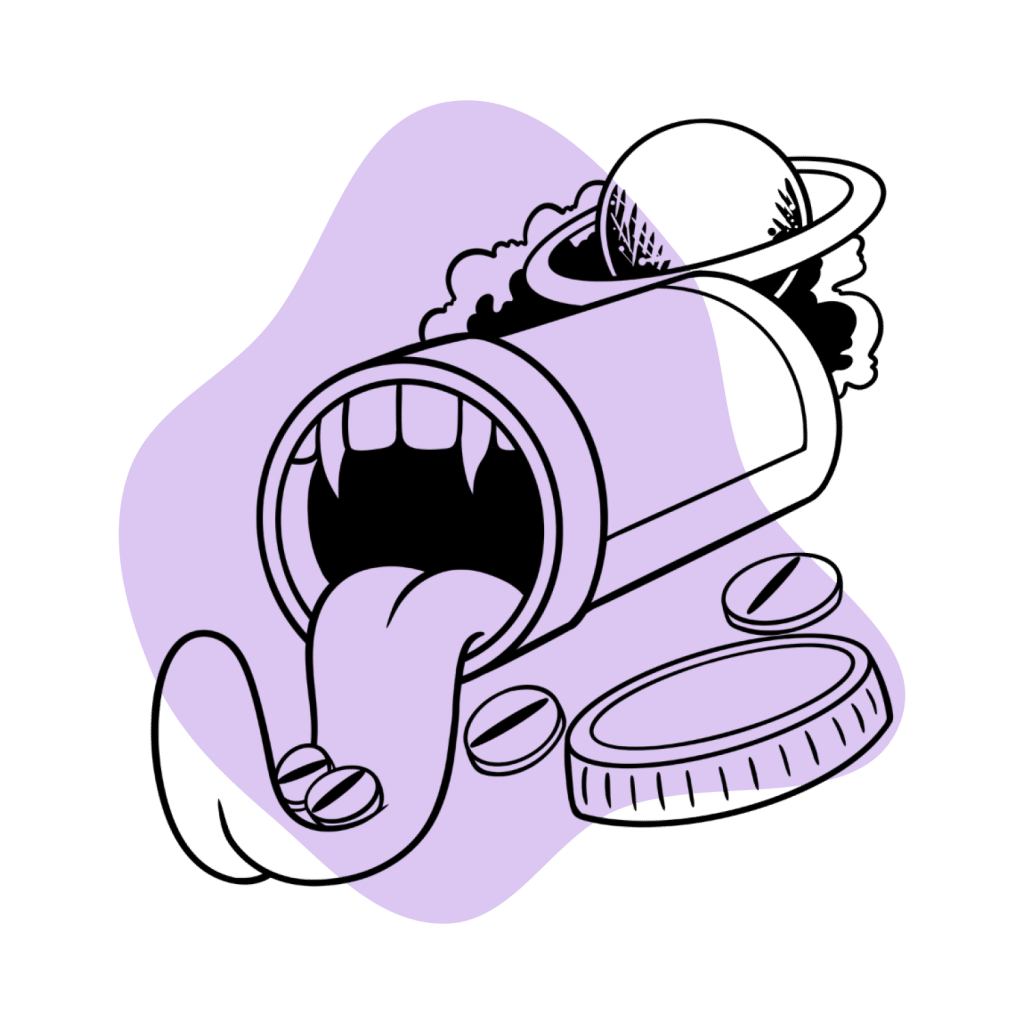
Benzodiazepine Dosage Equivalency Calculator
**Caution:** Benzodiazepines have a narrow therapeutic window. Dose equivalents may not be accurate in higher doses.
This calculator does not substitute for clinical experience and is meant to serve only as a reference for determining oral benzodiazepine equivalence.
Please consult a medical practitioner before taking benzodiazepines.
How Does Cinolazepam (Gerodorm) Work?
As a “classic” 1,4-benzodiazepine, cinolazepam exerts its pharmacologic effects through its status as a positive allosteric modulator, which is the broadly utilized mechanism of action of the vast majority of benzodiazepines.
In simple terms, it consists of benzodiazepine molecules binding to special receptor sites located on GABA-A neurotransmitters. When benzodiazepine molecules bind to these receptors, they produce an allosteric effect, which is a fancy way of saying they potentiate the natural inhibitory effects of GABA. This is done by increasing the opening frequency of the chloride channels in GABA receptors, leading to the neurons becoming hyperpolarized, another term for a change in their electrical valence.
The now hyperpolarized neurons are less likely to fire off an action potential, and, in this way, there is an overall “slowing down” of activity in the brain and central nervous system (CNS). This generalized depressive effect gives rise to the traditional range of benzodiazepine-related properties.
In terms of specifics, there is not much that’s widely known about the pharmacology of cinolazepam. We do know that its effects are skew towards the hypnotic, anxiolytic side of the benzodiazepine spectrum and away from the sedative and anticonvulsant effects. Still, besides that, there is not a lot of information available in terms of pharmacokinetics and secondary mechanisms of action.
We do know that in terms of sleep benefits, cinolazepam allows patients to wake up less often during the night and extends average sleep duration.
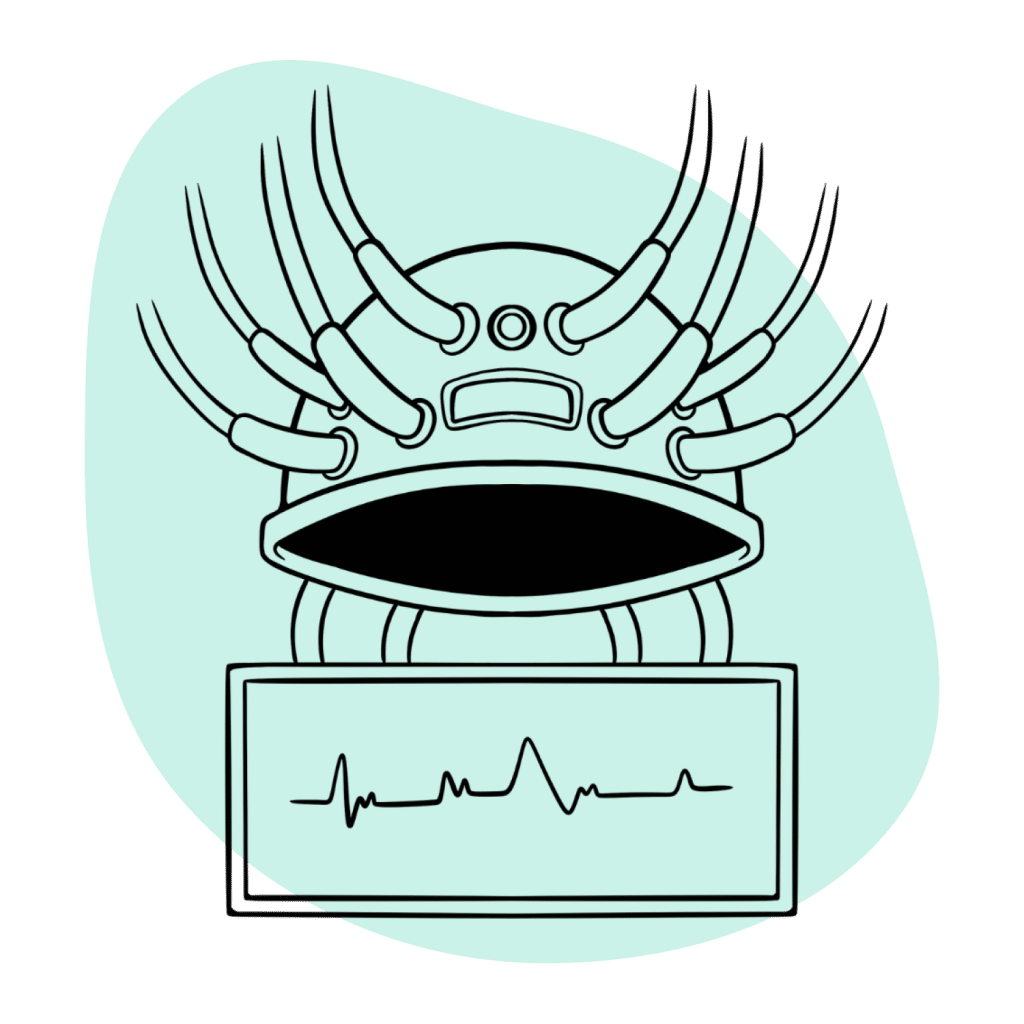
Is Cinolazepam (Gerodorm) Safe? Risks & Side Effects
Like all benzodiazepines or any prescription drug, for that matter, cinolazepam carries a certain level of risk. It is not an approved medication in the United States, but cinolazepam has received a Schedule IV designation under the Controlled Substances Act. This signifies that although US health authorities recognize its medical potential, it can also cause dependence and withdrawal symptoms among users.
Almost all benzodiazepines share this Schedule IV designation, so, in this sense, it is of limited help when attempting to gauge the individual risk level tied to a given benzodiazepine. For these types of assessments, we have to rely on what other data we can find and our ability to make educated assumptions.
Given that benzodiazepine hypnotics are only supposed to be taken right before bed, these types of benzodiazepines are much less likely to be abused, and thus their inherent risk level tends to be lower. Additionally, cinolazepam is a compound of relatively low potency, so there is less of a chance for severe adverse effects to develop. However, this doesn’t imply that the compounds can’t still be abused.
In general, benzodiazepines are safe compounds when taken in accordance with a prescription. If a benzodiazepine user does not engage in any sort of misuse, cinolazepam is to be considered a safe product to consume.
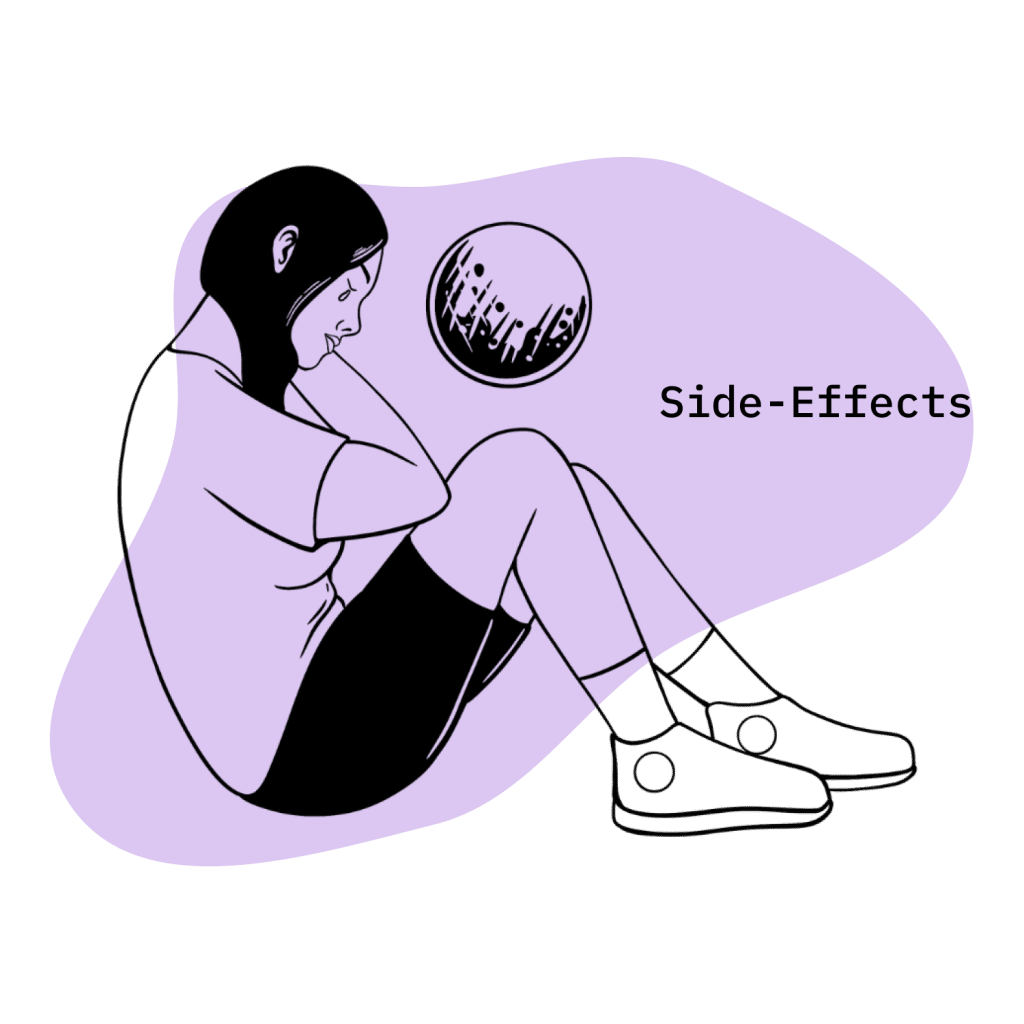
Side Effects of Cinolazepam (Gerodorm)
Cinolazepam has its fair share of side effects which users should know about.
According to the cinolazepam fact sheet in Romania, cinolazepam use has been associated with the following side effects:
- Amnesia
- Cardiac disorders
- Change in libido
- Confusion
- Daytime sleepiness
- Decreased emotionality
- Decreased vigilance
- Diarrhea
- Dizziness
- Double vision (especially at the beginning of treatment)
- Drop in blood pressure
- Dryness of the oral mucosa
- Fainting
- Headaches
- Hunger
- Impaired coordination
- Increased heart rate
- Itching
- Lack of concentration
- Muscle weakness
- Nausea
- Occasional skin eruptions
- Restless leg syndrome
- Tiredness
- Vomiting
Rarer side effects, most frequent in elderly patients and patients with conditions, include:
- Fatigue
- Hangover effect
- States of agitation
Additionally, the following adverse effects can occur as a result of overdosing:
- Circulatory collapse
- Coma
- Death
- Decrease in muscle tension
- Deep sleep
- Insomnia
- Lack of coordination
- Loss of consciousness
- Restlessness
- Shallow breathing
Furthermore, patients should know that tolerance to the hypnotic effects of cinolazepam can develop. After stopping treatment, sleep disturbances may temporarily reappear, sometimes worse than before.
The chance of developing significant side effects is increased when cinolazepam is taken in conjunction with hypnotic, anesthetic, anticonvulsant, and antidepressant drugs.
Romanian health authorities have stated that cinolazepam is not a suitable drug for long-term treatment. In this sense, the treatment span should always be as limited as possible, usually between a few days to two weeks. In any case, treatment should not exceed three weeks, as there is a significant chance of developing a benzodiazepine dependence.
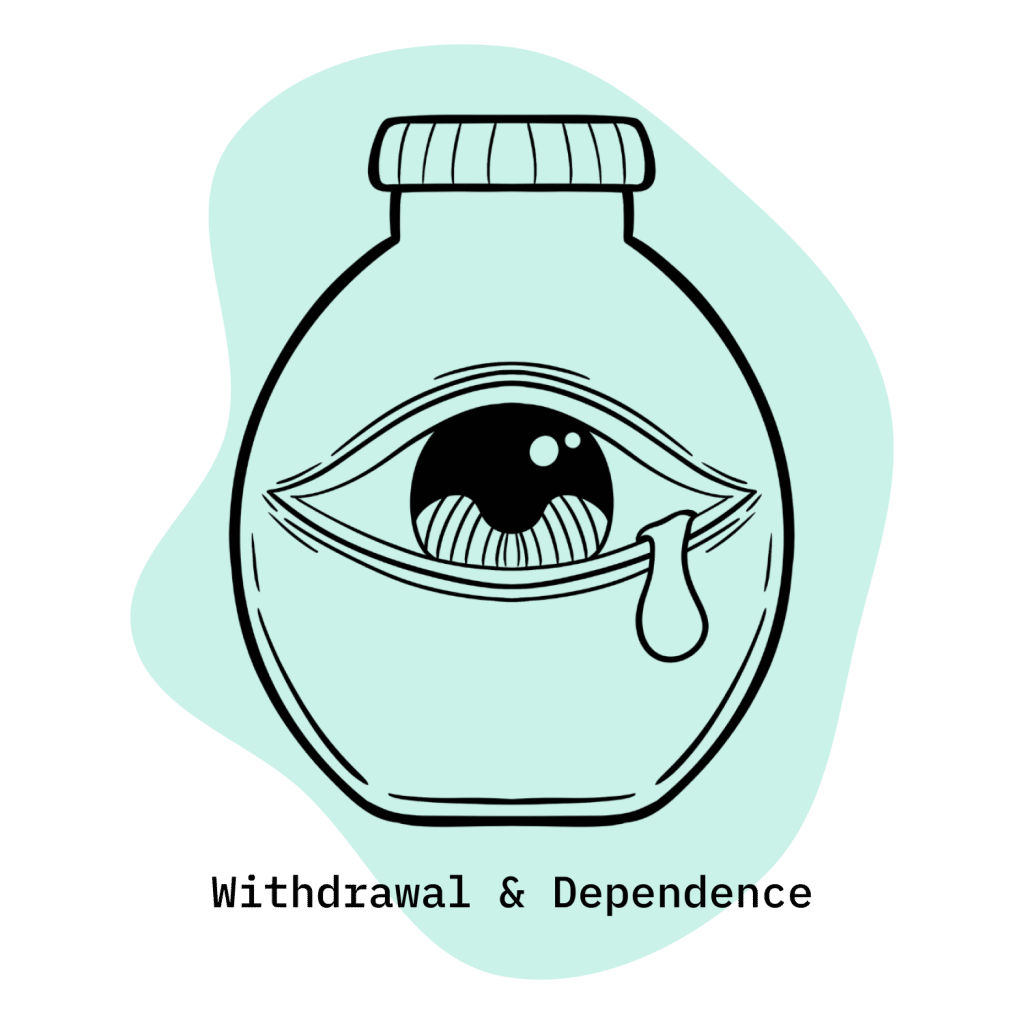
Benzodiazepine Withdrawal & Dependence
Virtually all benzodiazepines have a considerable capacity to engender dependence, as well as the accompanying withdrawal symptoms, and that includes cinolazepam.
Romanian health authorities have stated that cinolazepam treatment should not be discontinued suddenly. Sudden stoppage has the potential to cause withdrawal symptoms and a worsening of the very sleep disorders cinolazepam was meant to treat. This is condition known as rebound insomnia. In this sense, doctors should use gradual tapering to safely get their patients off cinolazepam. Incidentally, this is a major reason why benzodiazepine should not be consumed recreationally; drug tapering is a complex procedure and should only be done by a doctor.
Light withdrawal symptoms for cinolazepam are headaches, muscle pain, anxiety, tension, restlessness, confusion, and irritability. In more extreme cases, there can be perception disorders, personality disorders, sensations of numbness, hypersensitivity to light, hallucinations, and epileptic seizures.
Harm Reduction: Cinolazepam (Gerodorm)
It’s important for prescription and recreational benzodiazepine users to have a basic understanding of harm reduction tactics, so they can always have the means to make decisions that will allow them to stay safe.
In this sense, the number one recommendation for prescription users is to try their hardest not to engage in misuse. Prescription drug users often think that misuse is synonymous with recreational use, but this is not true. Misuse can imply a variety of behaviors, such as altering your dose without consulting your doctor, altering your formulation, or changing the time when you’re supposed to take your benzodiazepine (this is especially critical with hypnotic compounds). Another common form of misuse is inadvertently engaging in a contraindication.
The other crucial recommendation is to limit the duration and dosage. Reducing these two factors is the best way to minimize the chance for dependence to form. However, the dosage shouldn’t be reduced to the point that it significantly affects the treatment’s chance of success.
For recreational users, things are a bit different, as they are, by definition, always engaging in misuse. Here the recommendations have to be a bit more practical.
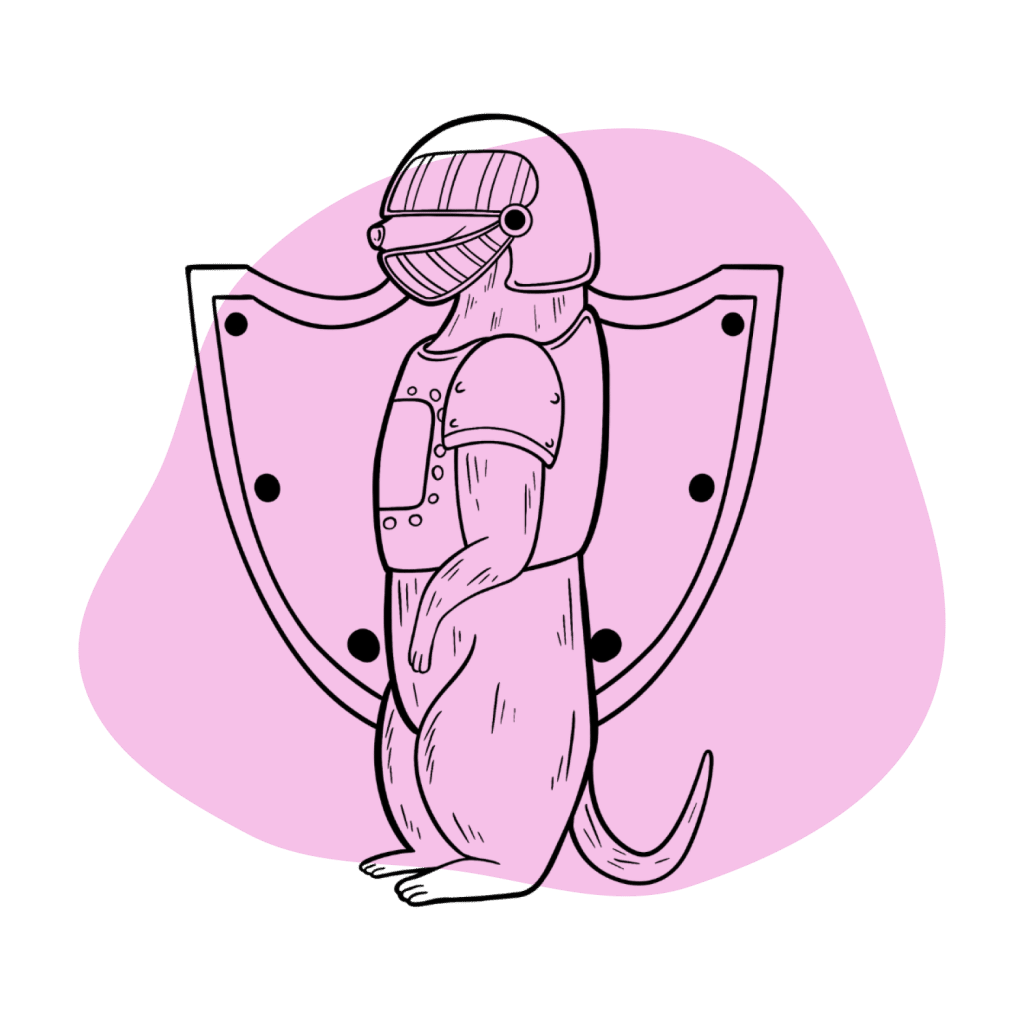
Recreational users should always attempt to stay away from mixing potent pharmacological compounds, as this will always have the effect of raising risk levels. And this doesn’t just apply to prescription drugs: alcohol is a drug that should never be mixed with other pharmacological compounds.
Additionally, recreational users should try to engage in drug use by themselves. At the very least, they should let a friend know of their plans. And finally, it is a good idea to inquire about flumazenil at your local harm reduction facility. Flumazenil is a benzodiazepine receptor antagonist and can reverse the effects of an opioid overdose.
Benzodiazepine Harm Reduction Tips
- 🥣 Don’t mix — Mixing benzodiazepines with other depressants (alcohol, GHB, phenibut, barbiturates, opiates) can be fatal.
- ⏳ Take frequent breaks or plan for a short treatment span — Benzodiazepines can form dependence quickly, so it’s important to stop using the drug periodically.
- 🥄 Always stick the proper dose — The dosage of benzos can vary substantially. Some drugs require 20 or 30 mg; others can be fatal in doses as low as 3 mg.
- 💊 Be aware of contraindications — Benzodiazepines are significantly more dangerous in older people or those with certain medical conditions.
- 🧪 Test your drugs — If ordering benzos from unregistered vendors (online or street vendors), order a benzo test kit to ensure your pills contain what you think they do.
- 💉 Never snort or inject benzos — Not only does this provide no advantage, but it’s also extremely dangerous. Benzos should be taken orally.
- 🌧 Recognize the signs of addiction — Early warning signs are feeling like you’re not “yourself” without the drug or hiding your habits from loved ones.
- ⚖️ Understand the laws where you live — In most parts of the world, benzodiazepines are only considered legal if given a prescription by a medical doctor.
- 📞 Know where to go if you need help — Help is available for benzodiazepine addiction; you just have to ask for it. Look up “addiction hotline” for more information where you live. (USA: 1-800-662-4357; Canada: 1-866-585-0445; UK: 0300-999-1212).
Cinolazepam (Gerodorm) Drug Interactions
When it comes to hypnotic benzodiazepines like cinolazepam, the concomitant use of other prescription drugs can have the effect of increasing the sedative effects of the benzodiazepine, and thus users should always consult with their doctors if they want to utilize another prescription compound.
Furthermore, cinolazepam users should know to stay away from other CNS-depressant compounds. Mixing two drugs that exert a depressive effect on the CNS is extremely dangerous. This is the most common way users put themselves at risk of severe respiratory depression, which is the leading cause of death among drug overdoses.

Cinolazepam (Gerodorm) Contraindications
All non-atypical benzodiazepines share a common set of contraindications. These include:
- Bronchitis
- Chronic obstructive pulmonary disease (COPD)
- Conjunctive use of barbiturates, opiates, or those suffering from alcoholism
- Intellectual disabilities due to frequent paradoxical reactions
- Major depression
- Myasthenia gravis
- Over the age of 65 (high risk)
- Personality disorders
- Sleep apnea
Additionally, in the case of cinolazepam, use during pregnancy and lactation is also contraindicated. Doctors also recommend that users be careful if they are driving or using any type of heavy machinery, as there could be adverse effects that negatively impair their ability to carry out these tasks. The consumption of ethyl alcohol is also contraindicated for cinolazepam.
Cinolazepam Dosage
According to Romanian health authorities, the appropriate dosage for cinolazepam is one 40 mg tablet. The initial starting dose should be half a tablet for elderly users, those with hepatic impairment, and certain types of chronic respiratory diseases. If these users feel they need a dosage increase, they should consult their doctor.
Similar Benzodiazepines
Here are some benzodiazepines with general properties similar to cinolazepam.
Diazepam
Cinolazepam has a comparable potency to diazepam (Valium) and is regarded as having similar pharmacological properties. When it comes to the wide variety of existing benzodiazepines, diazepam is a benchmark when comparing the potency of other benzodiazepines.
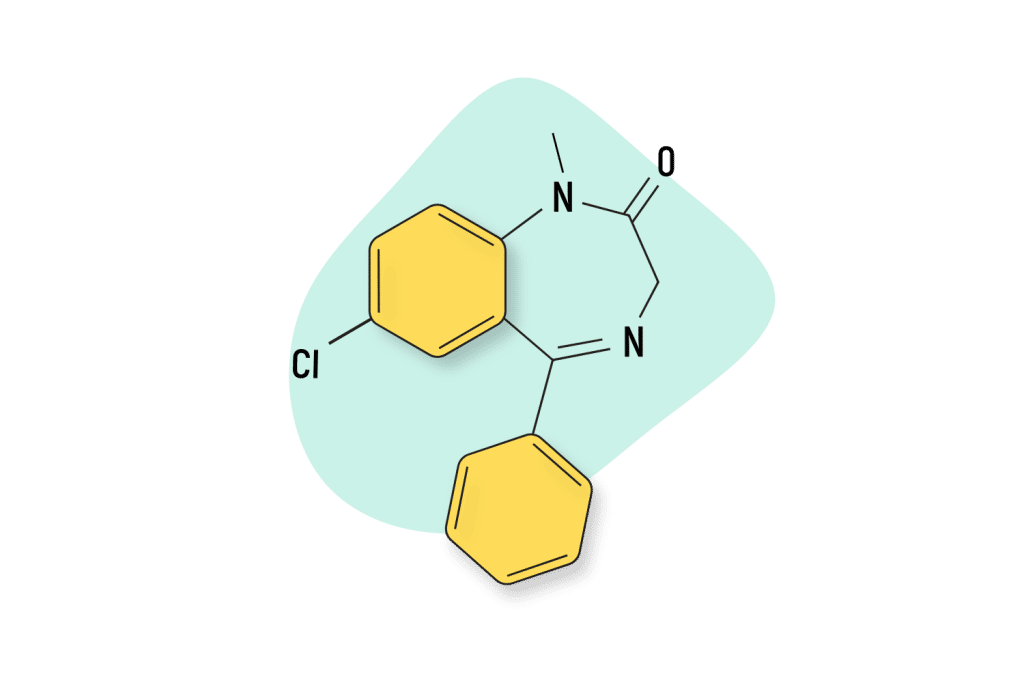
Temazepam
Temazepam is another benzodiazepine hypnotic with a half-life almost identical to cinolazepam (10 to 15 hours). This is an important trait in hypnotics as it is a crucial determiner of their clinical efficacy. The effects of hypnotics that are too short-acting don’t last throughout the night, while long-acting hypnotics often present the problem of hangover effects and daytime sleepiness.
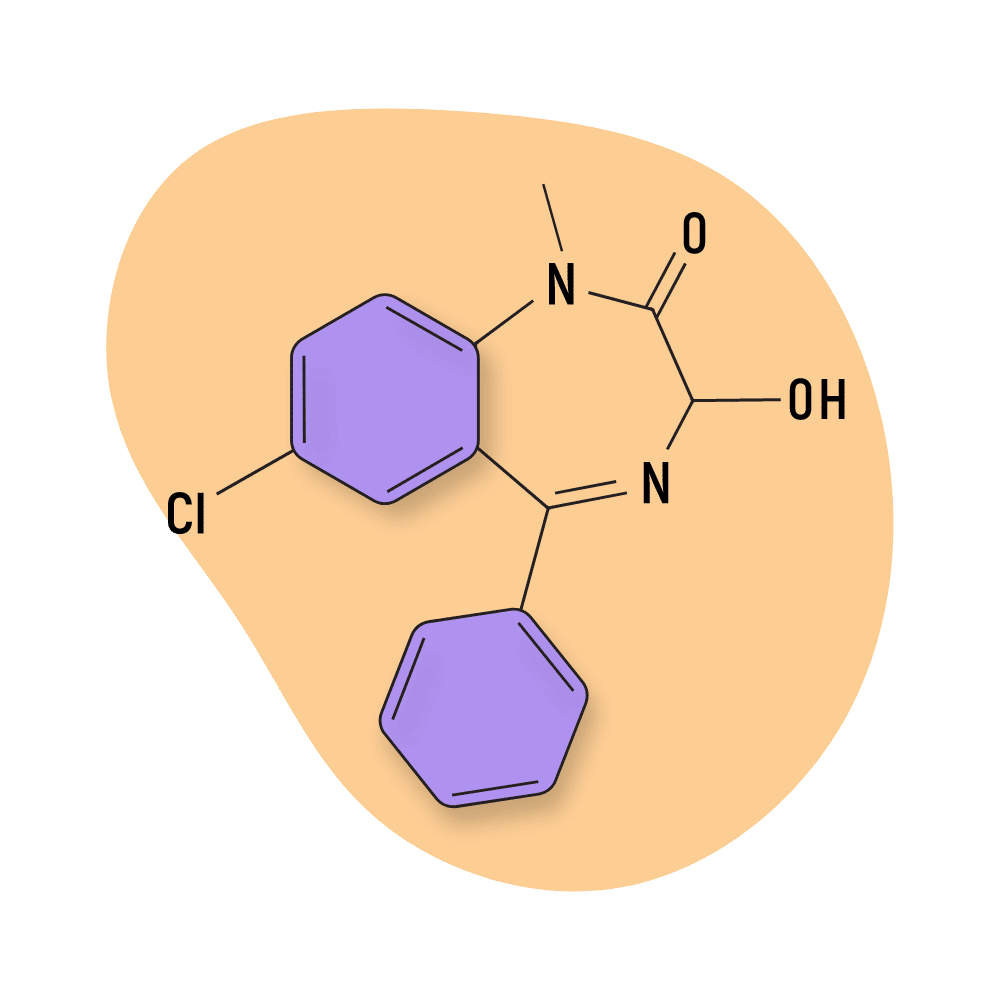
Natural Alternatives to Benzodiazepines
Many natural alternatives to benzodiazepines have gained prominence as people have begun to move away from prescription drugs.
Kava
The kava plant is a tropical plant species with natural anxiolytic and sedative benefits [3]. Like benzodiazepines, kava achieves these effects through its interactions with GABA-A receptors. However, users should know that kava cannot be as potent as a benzodiazepine. But, on the other hand, it offers far fewer side effects and less dependence liability.
Kratom
Kratom boasts a wide breadth of pharmacological properties and the fact that, amongst other natural compounds, it is relatively potent, probably a result of its interactions with opioid receptors. When taken in low doses, kratom offers stimulant and euphoric benefits, while in mid-to-high doses, kratom begins to act as an anxiolytic, analgesic, and sedative [4].
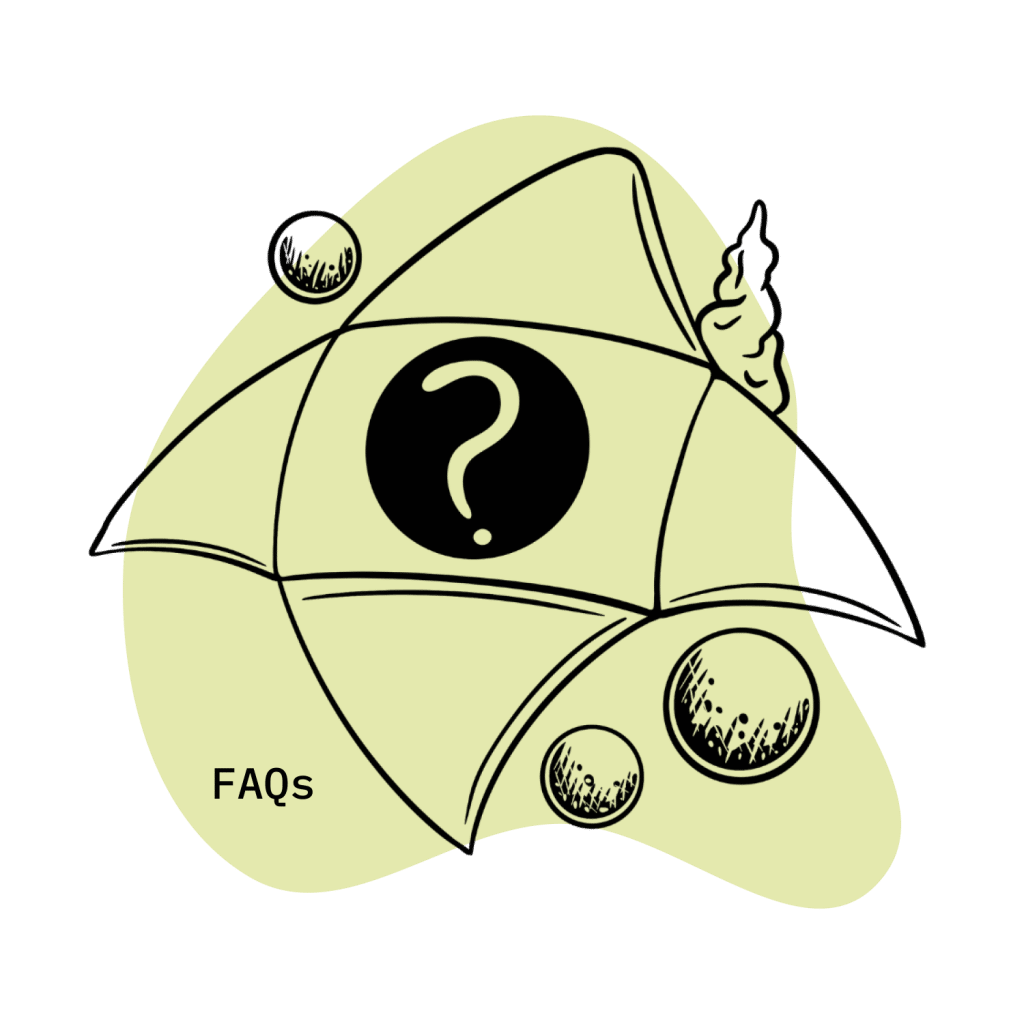
Cinolazepam (Gerodorm) FAQs
What other components are included in Gerodorm (cinolazepam) tablets?
Other components utilized in Gerodorm oral tablets are lactose monohydrate, corn starch, gelatin, starch glycolate, sodium type A, magnesium stearate, and talc.
What formulations is cinolazepam available in
Cinolazepam, as Gerodorm, is available in oral tablets of 40 mg
What is the bioavailability of cinolazepam?
After oral ingestion, cinolazepam has a bioavailability of 90 to 100%.
References
- Watanabe, S., Vikingsson, S., Åstrand, A., Auwärter, V., Green, H., & Kronstrand, R. (2020). Metabolism of the benzodiazepines norflurazepam, flurazepam, fludiazepam, and cinolazepam by human hepatocytes using high-resolution mass spectrometry and distinguishing their intake in authentic urine samples. Forensic Toxicology, 38(1), 79-94.
- Saletu, B., Kindshofer, G., Anderer, P., & Grünberger, J. (1987). Short-term sleep laboratory studies with cinolazepam in situational insomnia induced by traffic noise. International journal of clinical pharmacology research, 7(5), 407-418.
- Pittler, M. H., & Ernst, E. (2003). Kava extract for treating anxiety. Cochrane Depression, Anxiety and Neurosis Group. Cochrane Database Syst Rev, 3.

